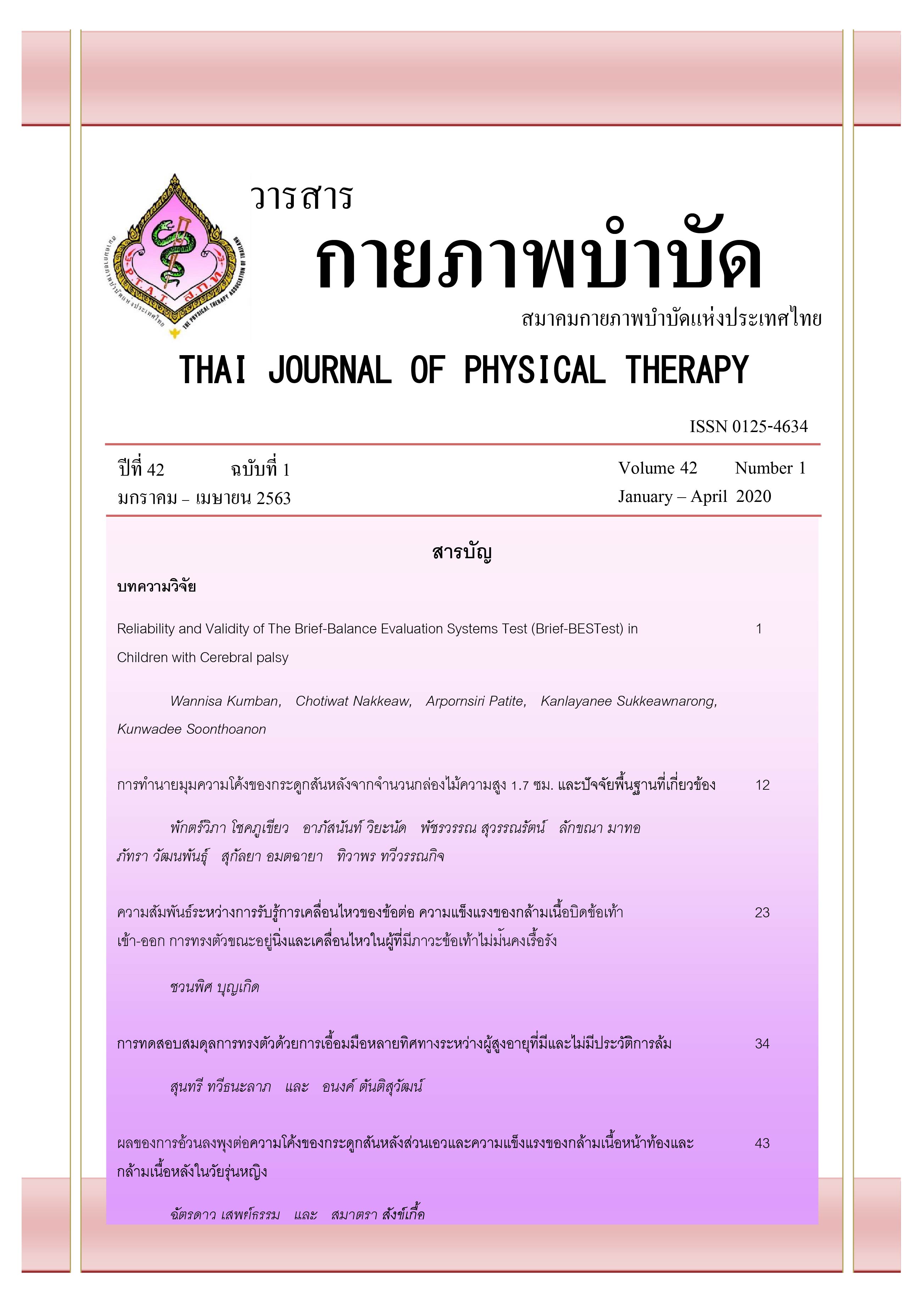ผลของการอ้วนลงพุงต่อความโค้งของกระดูกสันหลังส่วนเอวและความแข็งแรงของกล้ามเนื้อหน้าท้องและกล้ามเนื้อหลังในวัยรุ่นหญิง
Main Article Content
บทคัดย่อ
ที่มาและความสำคัญ: อ้วนลงพุงเป็นปัญหาสุขภาพที่ทำให้เกิดโรคทางระบบกระดูกและกล้ามเนื้อเนื่องจากทำให้จุดศูนย์ถ่วงของร่างกายมีการเคลื่อนมาทางด้านหน้าต่อกระดูกสันหลังส่วนเอวมากกว่าปกติ ทำให้มีท่าทางที่เปลี่ยนแปลงไปจากปกติ ส่งผลให้มีแรงกระทำต่อกระดูกสันหลังมากขึ้นที่อาจนำไปสู่การเกิดความผิดปกติของกระดูกสันหลังและกล้ามเนื้อได้
วัตถุประสงค์: เพื่อเปรียบเทียบความโค้งของกระดูกสันหลังส่วนเอวและความแข็งแรงของกล้ามเนื้อหน้าท้องและกล้ามเนื้อหลังระหว่างคนที่มีน้ำหนักปกติและคนอ้วนลงพุงในวัยรุ่นหญิงและเพื่อศึกษาความสัมพันธ์ระหว่างเส้นรอบเอวกับความโค้งของกระดูกสันหลังส่วนเอวและความแข็งแรงของกล้ามเนื้อกล้ามเนื้อหน้าท้องและกล้ามเนื้อหลัง
วิธีการวิจัย: วัยรุ่นหญิงจำนวน 52 คน อายุระหว่าง 18-25 ปี แบ่งเป็น 2 กลุ่ม คือกลุ่มคนที่มีน้ำหนักปกติและ คนอ้วนลงพุง มีระดับกิจกรรมทางกายในระดับปานกลาง โดยทั้ง 2 กลุ่มได้รับการวัดความโค้งของกระดูกสันหลังส่วนเอวด้วย flexible ruler และทดสอบความแข็งแรงของกล้ามเนื้อหน้าท้องและกล้ามเนื้อหลังด้วย handheld dynamometer
ผลการวิจัย: พบว่ามีความแตกต่างอย่างมีนัยสำคัญทางสถิติ (p<0.05) ของความโค้งของกระดูกสันหลังส่วนเอวและความแข็งแรงของกล้ามเนื้อหน้าท้องและกล้ามเนื้อหลังระหว่างคนที่มีน้ำหนักปกติ และคนที่มีภาวะอ้วนลงพุง (0.32±0.56, 0.23±0.55 และ0.37±0.55, 0.25±0.58 กิโลกรัม ตามลำดับ) และพบว่าเส้นรอบเอวมีความสัมพันธ์กับความโค้งของกระดูกสันหลังส่วนเอวและความแข็งแรงของกล้ามเนื้อกล้ามเนื้อหน้าท้องและกล้ามเนื้อหลังอย่างมีนัยสำคัญทางสถิติ
สรุปผล: ภาวะอ้วนลงพุงทำให้มีการเพิ่มขึ้นของความโค้งของกระดูกสันหลังส่วนเอวและมีการลดลงของความแข็งแรงของกล้ามเนื้อกล้ามเนื้อหน้าท้องและกล้ามเนื้อหลัง นอกจากนี้เส้นรอบเอวยังมีความสัมพันธ์เชิงบวกกับความโค้งของกระดูกสันหลังส่วนเอวและมีความความสัมพันธ์เชิงลบกับความแข็งแรงของกล้ามเนื้อ หน้าท้องและกล้ามเนื้อหลัง แสดงให้เห็นว่าภาวะอ้วนลงพุงทำให้เกิดการเปลี่ยนแปลงของโครงสร้างกระดูกและกล้ามเนื้อที่อาจนำไปสู่การเกิดปัญหาปวดหลังส่วนล่างในผู้ที่มีภาวะอ้วนลงพุงได้ในอนาคต
Article Details
เอกสารอ้างอิง
Onat A, Avci GS, Barlan MM, Uyarel H, Uzunlar B, Sansoy V. Measures of abdominal obesity assessed for visceral adiposity and relation to coronary risk. Int J Obes Relat Metab Disord. 2004; 28:1018-25.
Nitiyanon W. Obesity and Abdominal obesity [database on Internet] 2011.[cited October 2018]. Available from: https://resource.thaihealth.or.th/system/files/documents/wnaelawnlngphung_1-216_-cchb- khrb.pdf.
Global data base on Body Mass Index. [database on Internet] 2015. [cited October 2018]. Available from: https://apps.who.int/bmi/index.jsp?introPage=intro_5.html.
Tantivess S, Saengow U, Yothasamut J, Teerawattananon Y. An Evaluation of the National Health Examination Survey in Thailand [database on Internet] 2017. [cited February 2018]. Available from: file:///C:/Users/Admin/Downloads/Report_NHES-Evaluation.pdf.
Aekplakorn W. Thai National Health Examination Survey, NHES V [database on Internet] 2013. [cited February 2018]. Available from: https://www.thaiheart.org/images/column_1387023976/NHES5_EGATMeeting13Dec13.pdf.
Peltonen M, Lindroos AK, Torgerson JS. Musculoskeletal pain in the obese: a comparison with a general population and long-term changes after conventional and surgical obesity treatment. Pain. 2003;104(3): 549-57.
Mellin G HK, Vanharanta H. Outcome of a multimodal treatment including intensive physical training of patients with chronic low back pain. Spine. 1993;18: 825-9.
Taweetanalarp S, Purepong N. Comparison of lumbar spinal angle between normal body mass index and overweight young adults. J Phys Ther Sci. 2015; 27(7): 2343-6.
Pichaiyongvongdee N, Kurustien N. Trunk muscle strength in women with overweight or obesity. J Med Tech Phy Ther. 2016; 28(3): 251-9.
Hulen M, Vansant G, Lysens R, Claessens AL, Muls E, Brumagne S. Study of differences in peripheral muscle strength of lean versus obese women: an allometric approach. Int J Obes Relat Metab Disord. 2001; 25(5): 676-81.
Taylor RW, Jones IE, Williams SM, Goulding A. Evaluation of waist circumference, waist-to hip ratio, and the conicity index as screening tools for high trunk fat mass, as measured by dual-enerdy X-ray absorptiometry, in children aged 3-19 y. Am J Chin Nutr. 2000; 72(2): 490-5.
Onyemaechi NO, Anyanwu GE, Obikili EN, Onwuasoigwe O, Nwankwo OE. Impact of overweight and obesity on the musculoskeletal system using lumbosacral angles. Patient Prefer Adherence. 2016; 10: 291-6.
Jaturapatporn D HS, Manataweewat B, Dellow AC, Leelaharattanarak S, Sirimathya S. Reliability and validity of a Thai version of the General Practice Assessment Questionnaire (GPAQ). J med Assoc Thai. 2006; 89: 1491-6.
Rajabi R, Seidi F, Mohamadi F. Which Method Is Accurate When Using the Flexible Ruler to Measure the Lumbar Curvature Angle? Deep Pint or mid Point of Arch?. World Appl Sci J. 2008; 4(6): 849-52.
McGraw B MB, Williams HG. Gait and posture stability in obese and nonobeseprepubertal boys. Arch Phys Med Rehabil. 2000; 81: 484-9.
Vismara L, Menegoni F, Zaina F, Galli M, Negrini S, Capodaglio P. Effect of obesity and low back pain on spinal mobility: a cross sectional study in women. J Neuroeng Rehabil. 2010; 7: 1-8.
Fabris de Souza SA, Faintuch J, Valezi AC, Sant’Anna AF, Gama-Rodrigues JJ, et al. Postural Changes in Morbidly Obese Patients. Obes Surg. 2005; 15(7): 1013-6.
Puntumetakul R, Hiruntrakul P, Premchaisawat W, Puntumetakul M, Thavornpitak Y. The measurement of lumbar spinal curvature in normal Thai population aged 20-69 years using flexible ruler. J Med Tech Phy Ther. 2012; 24(3): 308-17.
Tomlinson DJ, Erskine RM, Morse CI, Winwood K, Onambélé-Pearson G. The impact of obesity on skeletal muscle strength through adolescence to old age. Biogerontology. 2016; 17(3): 467-83.
Rahemi H, Nigam N, Wakeling JM. The effect of intramuscular fat on skeletal muscle mechanics: implications for the elderly and obese. J R Soc Interface. 2015; 12(109): 2-8.
Sitnick M, Bodine SC, Rutledge JC. Chronic high fat feeding attenuates load-induced hypertrophy in mice. J Physiol. 2009; 587(Pt 23):5753-65.


